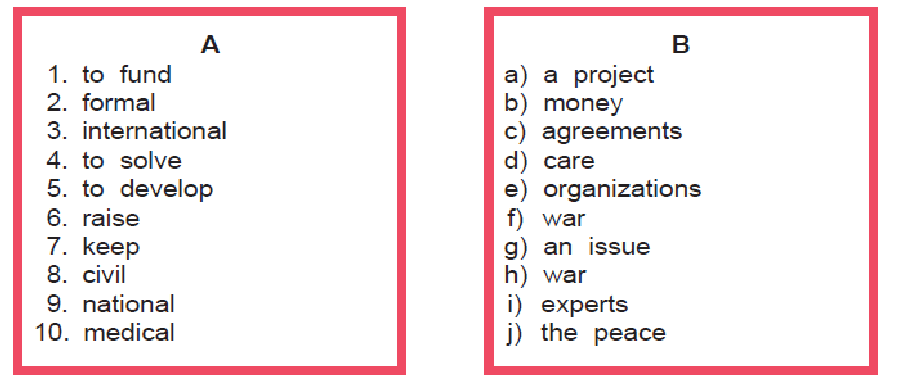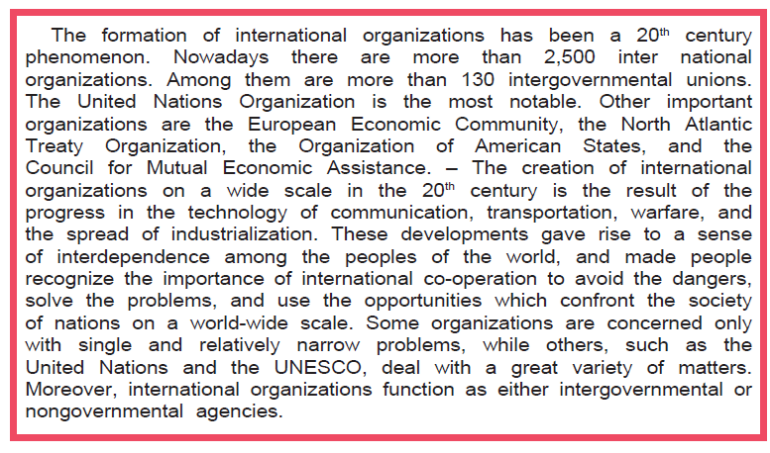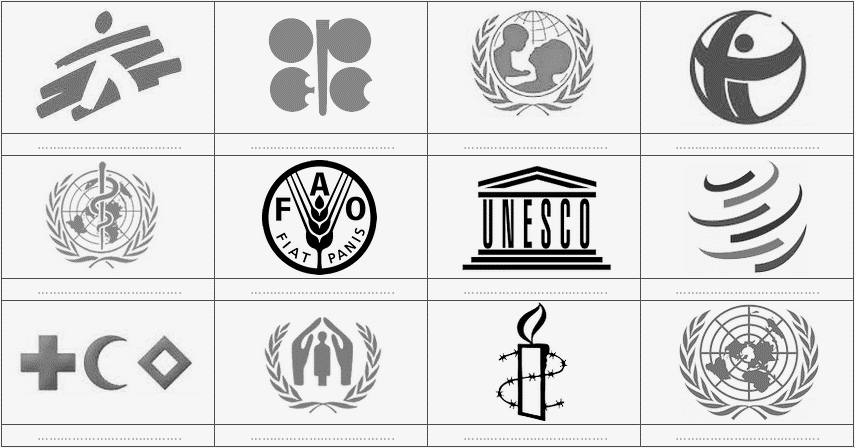Lesson 1A. International organizations
The aim of the lesson:
Educational: - According to the lesson’s educational purpose improve pupil’s political knowledge; to raise awarenes of different international organizations
Developing: According to the lesson’s educational purpose develop pupils’ personal skills, English learning, motivational skills, develop pupils’ self-educational skills;
- to develop reading for gist, listening for detailed information
Up-bringing: According to the lesson’s upbringing purpose is to bring up pupils yo be interested in subjects, other cultures
Socio-cultural:to raise awareness of international organizations and their aim, policy and duties
Learning outcomes for English competence C1, C2, C3, C4, C5, C6:
- By the end of the lesson pupils will be able to speak about intteligence, effort and success Pupils will be able to pronounce words
- By the end of the lesson, pupils will be able to understand to learn phrases for the theme and use them in small situations
- By the end pupils will able to to enable pupils to understand and perform commands, to enable pupils to learn Priority organizer’
Equipments: “English” pupil’s book 10, handouts, DVD, technical aid, a blackboard and a piece of chalk.
The method of the lesson: untraditional.
| № | Part of the lesson | Tasks | Time |
| 1 | Organizational Moment | -to greet pupils. - check homework, ask vocabulary | 3 min |
| 2 | Repeating last lesson | - to give pupils some questions about last lesson. | 5 min |
| 3 | Explaining new theme | - to explain to pupils new vocabulary and theme | 20min |
| 4 | Consolidating new theme. | - to consolidate new theme and new words of the theme. | 12 min |
| 5 | Marking. | - To mark pupils | 2 min |
| 6 | Homework. | - Giving homework. | 3 min |
Procedure of the lesson:
I. Organizing moment: Motivation,Greeting, checking attendance, season, weather, checking the preparation for the lesson.
II. Asking homework:
- Check for homework given on past lesson.
Ask pupils all new words learnt on previous lesson.
III. Presentation -Explain new theme: 1A Internatioanal Organizations
IV. Pre-activity:
Warming up:
Take a list of words that your students have recently learned and write a scrambled version of each on the board. Allow students to unscramble the words on their paper. The first one to finish deciphering all the words wins.
V. Main part
Activity 1Let your pupils read questions and check their knowledge about international organizations.
Answer key:
1. D 2. A 3. B 4. D 5. C 6. A 7. D 8. B 9. B
Activity 6Your pupils should fill in each blank with the best word from the box. They use each world only once.
Answer key:
1. organization
2. economic
3. original
4. United
5. former
6. part
7. dependent
8. members
9. countries
10. members
Extra activities:
- Match each acronym with what it stands for:
| 1 | UN | A | The United Nations Office of the High Commissioner for Refugees | |
| 2 | UNESCO | B | WorldHealthOrganization | |
| 3 | UNICEF | C | TheUnitedNations | |
| 4 | UNHCR | D | WorldTradeOrganization | |
| 5 | WHO | E | The United Nations Educational, Scientific and Cultural Organization | |
| 6 | FAO | F | AmnestyInternational | |
| 7 | ICRC | G | The United Nations International Children’s Emergency Fund | |
| 8 | TI | H | Organization of the Petroleum Exporting Countries | |
| 9 | AI | I | Doctors Without Borders (Médecins Sans Frontières) | |
| 10 | WTO | J | The International Committee of the Red Cross / Crescent / Crystal | |
| 11 | OPEC | K | TransparencyInternational | |
| 12 | DWB (MSF) | L | FoodandAgricultureOrganization |
- Write the acronym of the organization each logo represents
- Write the right acronyms of the organizations which have the following missions:
- ……………………………….: Caringforrefugees.
- ……………………………….: Fighting epidemics around the world.
- ……………………………….: Safeguardinghumanrights.
- ……………………………….: Regulating business exchange in the worl
- Read the texts on p112-113 and use the information from the table to write a short paragraph on each organization:
Usefulexpressions:
- To talk about the year of foundation:
Name of organization + [came into existence / came into being / was established / was founded] + year
Examples:
- Amnesty International came into existence in 1961.
- FAO was founded on 16 October 1945.
- To mentions the place of its headquarters:
[Its headquarters is in / Its headquarters is located in / Its headquarters can be found / It has its headquarters in] + city
Examples:
- Amnesty International has its headquarters in London.
- FAO’s headquarters is in Quebec.
- To talk about the mission or objectives:
[Its missions are / Its objectives are / It aims at / It works towards] + missions or objectives
VII. Homework
• Make a list of vocabulary which you have learned today?
• Try to find international organization of UZBEKISTAN.


 Answer key:
Answer key:
















